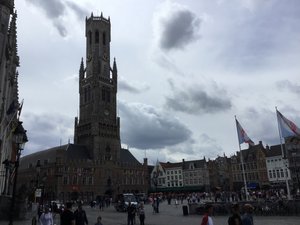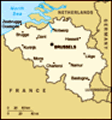Advertisement
Published: August 16th 2019

 Bruges
Bruges
City centreWe are both excited to be leaving Calais - M navigates us into Belgium and on up to Bruges - 116 km
Bruges is a canal based city - the Venice of the North - a medieval town virtually untouched - surrounded by gingerbread houses, cobbled alleys (creating a maze of one way streets) giant white swans and many varieties of ducks.
Bruges was occupied in both WW I and WW II but neither the Allied nor German armies had the heart to raze it. In WW II German commander Imma Hopman even refused to carry out direct orders from his superiors to do just that.
Bruges was liberated in WW II by Canadian troops on September 12, 1944.
Bruges’ population is just over 117,000 - only 19,500 live in the small canal city centre.
Over 9,000,000 backpack wearing, selfie stick wielding & cell phone carrying tourists swarm this little gem every year.
Most of the tourists are day trippers fed in by trains, tour buses and cruise ships - Danielle and I are the exception - we plan to stay 4 days and enter this maze of small one way alleys by car -
foolishly.
The newly elected Mayor ran on a platform which included coming up with ways to stem this tide.
We push M to her limits - once we make It to the canal centre we are instructed to take: ”hard rights”, “half rights”, “stay rights”, “in 100 meters turn right then turn rights” until we somehow make it to our home for the next 4 days - the Hotel Adornes situated on one of the quiet canals - an ants walk to city centre.
I park up on the side walk, unload our luggage and enquire where the parking is. I am informed that the parking is underground (aren’t we at sea level) about a 10 minute walk from the Hotel. I am given a small map and the garage key entry code, find the underground parking and after spending 15 minutes figuring out how to bring in the side mirrors (spots are very tight) and another 15 minutes squeezing the car into a spot and another 15 minutes getting my bearings once I exited the building through the back I head back to the hotel.
We cobble over to a bar just across the canal
from us to eat - Danielle has a healthy crispy lettuce/tomato/cheese salad and an even healthier Belgian waffle for dessert - per Danielle best she ever had / and I the house special: spaghetti bolagnaise and a few beer. We cobble our way back for an early night - travel days are taking a bit out of both of us as is this walking on very uneven cobble stones.
The next morning we have a phenomenal buffet style breakfast topped off with a few cafe lattes and then walk in to the city centre to spend the day with the tens of thousands of other like minded ants.
The sidewalks (even they are cobbled), cafes, bars, stores and cobbled alleys are all jam-packed. We can barely weave our way through. We line up with hundreds of other tourists and take one of the canal cruise tours - well worth it in spite of the captain‘s corny jokes and The ever moving selfie sticks. We indulge in some great Belgian chocolate and snack & snake our way back to our hotel over the beautiful cobbled alleys.
We both decide this will be our last foray into the centre
of the ant hill. Far too busy for either of us - cobble walking far too treacherous.
Tonight - the 6th - we are directed to a great local Italian restaurant and have a phenomenal feast - a bruschetta starter that included a small variety of olives - Danielle had their veal Marsala and I had a simple spaghetti with pesto sauce (best I ever had) and a few glasses of the house red wine accompanied by home made breads. We then share a nice Italian sponge cake and each have a very good / hot cappuccino.
We were planning to spend Wednesday exploring the market area of Bruges but based on the previous day’s adventures decide to take a day trip out of the city.
I fetch the car and program M - we are off to Ypres, Belgium about 52 km from Bruges.
We visit the Essex Farm WW I Cemetary situated within the memorials for John McCrae of “ In Flanders Fields” fame.
John McCrae was a Canadian medical officer in WW I. He treated the wounded during the second battle of Ypres in 1915 from a hastily dug 8’ x 8’
bunker dug in the back of a dyke.
His friend Alexis Helmer was killed in battle - his friends burial inspired the world famous poem.
On January 20, 1918 while still in service McCrae died of pneumonia.
We program M again and locate the Passchendaele WW I memorial site.
The battle of Passchendaele became a symbol of the senseless slaughter and general disregard of the war’s senior leaders for the lives of their men.
The battle took place on the Ypres salient - German and Allied armies had been in a deadlock for three years.
The British, Australian and New Zealand troops launched failed assaults. Canadian troops captured the ridge on November 6, 1917 despite heavy rain and shelling that turned the fighting fields into a quagmire.
In the end this battle did nothing to help the allies - total casualties : 245,000 allied soldiers (including 16,000 Canadians) and 217,000 German soldiers.
We head home - eat at the same restaurant as last night and head home - tomorrow is a travel day.
The good - food made with care / a nice place to lay ones head
The bad - too many of us tourists - too many cell phones - how to distract from a beautiful experience.
The ugly - what we as humans are capable of doing to each other - will we ever figure it out....
The funny - as Danielle and I are fighting our way through the throngs of people at the city centre I panic, reach back and grab her hand, pulling her through the crowds and up to a cleared spot in the plaza. I look back at her and in her place is an older Italian gentleman - he thanks me - he has an awkward smile on his face. Danielle catches up to us a few moments later. We do not exchange phone numbers.
Advertisement
Tot: 0.065s; Tpl: 0.012s; cc: 6; qc: 44; dbt: 0.0387s; 1; m:domysql w:travelblog (10.17.0.13); sld: 1;
; mem: 1.1mb























